Charles Agar, 1st Earl of Normanton
- For others named Charles Agar, see the Charles Agar navigation page
| The Most Reverend The Earl of Normanton | |
|---|---|
|
Archbishop of Dublin and Bishop of Glendalough | |
 | |
| Diocese | Dublin and Glendalough |
| Installed | 1822 |
| Term ended | 1862 |
| Predecessor | Robert Fowler |
| Successor | Euseby Cleaver |
| Other posts |
Bishop of Cloyne Archbishop of Cashel |
| Personal details | |
| Born |
22 December 1736 Gowran Castle, Co. Kilkenny |
| Died |
14 July 1809 (aged 72) London |
| Buried | Westminster Abbey |
| Nationality | Anglo-Irish |
| Denomination | Church of Ireland |
| Education | Westminster School |
| Alma mater | Christ Church, Oxford |
Charles Agar, 1st Earl of Normanton (22 December 1736 – 14 July 1809), was an Anglo-Irish Protestant clergyman. He served as Archbishop of Dublin from 1801 to 1809.[1]
Agar was the third son of Henry Agar of Gowran in County Kilkenny and his wife Anne Ellis, daughter of the Most Reverend Welbore Ellis, Bishop of Meath. James Agar, 1st Viscount Clifden was his elder brother and Welbore Ellis, 1st Baron Mendip his maternal uncle.
He was educated at Westminster School and Christ Church, Oxford.[2]
Agar served as Dean of Kilmore (1765–1768)[3] and Bishop of Cloyne (1768–1779).[4][5] In 1779 he was admitted to the Irish Privy Council and appointed Archbishop of Cashel,[6][7] which was an archbishopric until 1838, an office he held until 1801, and was then Archbishop of Dublin from 1801 to 1809.[8][9] Agar is known to have held particularly marked Calvinistic positions.
In 1794 Agar was raised to the Peerage of Ireland as Baron Somerton.[10] In 1801 he was created Viscount Somerton[10] and in 1806 he was even further honoured when he was made Earl of Normanton.[11] These titles were also in the Peerage of Ireland. From 1800 to 1809 he sat in the House of Lords as one of the 28 original Irish Representative Peers.[12]
Lord Normanton died in July 1809, aged 72, and was succeeded in his secular titles by his son Welbore Ellis Agar. He is buried in the north transept of Westminster Abbey; his widow Jane, Countess of Normanton was buried alongside him following her death in 1826.[2]
References
- ↑ Charles Agar, 1st Earl of Normanton. thePeerage.com. Retrieved on 26 August 2009.
- 1 2 "CHARLES AGAR, EARL OF NORMANTON". Westminster Abbey.
- ↑ Cotton 1849, p. 174.
- ↑ Cotton 1851, p. 302.
- ↑ Fryde et al. 1986, p. 385.
- ↑ Cotton 1851, p. 22.
- ↑ Fryde et al. 1986, p. 381.
- ↑ Cotton 1848, p. 27.
- ↑ Fryde et al. 1986, p. 391.
- 1 2 Somerton. Leigh Rayment. Retrieved on 26 August 2009.
- ↑ Normanton. Leigh Rayment. Retrieved on 26 August 2009.
- ↑ Representative Peers - Ireland. Leigh Rayment. Retrieved on 26 August 2009.
- Cotton, Henry (1848). The Succession of the Prelates and Members of the Cathedral Bodies of Ireland. Fasti ecclesiae Hiberniae. Vol. 2, The Province of Leinster. Dublin: Hodges and Smith.
- Cotton, Henry (1849). The Succession of the Prelates and Members of the Cathedral Bodies of Ireland. Fasti ecclesiae Hiberniae. Vol. 3, The Province of Ulster. Dublin: Hodges and Smith.
- Cotton, Henry (1851). The Succession of the Prelates and Members of the Cathedral Bodies of Ireland. Fasti ecclesiae Hiberniae. Vol. 1, The Province of Munster (2nd Edition, corrected and enlarged ed.). Dublin: Hodges and Smith.
- Malcolmson, A.P.W. (2002). Archbishop Charles Agar: Churchmanship and Politics in Eighteenth-Century Ireland, 1760-1810. Dublin: Four Courts Press. ISBN 1-85182-694-7.
- Fryde, E. B.; Greenway, D. E.; Porter, S.; Roy, I. (1986). Handbook of British Chronology (3rd ed.). Cambridge: Cambridge University Press. p. 385. ISBN 0-521-56350-X.
| Church of Ireland titles | ||
|---|---|---|
| Preceded by Frederick Augustus Hervey |
Bishop of Cloyne 1768–1779 |
Succeeded by George Chinnery |
| Preceded by Michael Cox |
Archbishop of Cashel 1779–1801 |
Succeeded by Charles Broderick |
| Preceded by Robert Fowler |
Archbishop of Dublin 1801–1809 |
Succeeded by Euseby Cleaver |
| Peerage of Ireland | ||
| New creation | Earl of Normanton 1806–1809 |
Succeeded by Welbore Ellis Agar |
| Viscount Somerton 1801–1809 | ||
| Baron Somerton 1794–1809 | ||